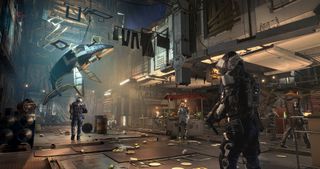Taking on the slums with new augs in Deus Ex: Mankind Divided
Eight hours with Eidos Montreal's cyberpunk thriller.

After two hours of playing Deus Ex Mankind Divided, I look around the press room. We’re halfway up a tower in central London, looming over the streets below, with the Shard framed in the window. On every screen, something wildly different is happening—after the linear (for Deus Ex) Dubai opening sequence, every single player of the ten or so journalists in the room has taken a different route into the main game. Presskind has been divided.
As the game’s lead writer, Mary DeMarle, tells me six hours later. “It’s not an open world; an open world is vast. Instead of going vast, we’re going deep. Literally, from the rooftops to the sewers.” My sample of Mankind Divided’s beginning reflects that—rather than push for the core story, I spent most of my eight hours exploring futuristic Prague in depth. I climbed out of windows, explored the rooftops and billboards, and went wading through sewer gas. I followed up conversations, deliberately rode in the non-Aug underground carriages to see what happened, and drunk every last bottle of booze I could find (roleplaying a typical foreigner in Prague.)
What’s fascinating about this sequel is how close we are to the previous prequel—and how far that still is from the original game. After all, this is set in 2029 and the original Deus Ex took place in 2052. “Doing the math, that’s like 23 years.” says DeMarle. So there’s room for 11 more sequels? “Ha-hah! Then we go back to prequels, and side stories and take different characters in the same timeline. There’s tons that can be done. We are introducing characters who will obviously have big roles to come in 2052.”
In terms of the main storyline, I decided to do a peaceful playthrough, trying to avoid doing anything lethal unless I really had to. The very first mission in Dubai (which we’ve already covered) starts by giving you some choices about your loadout—whether you’ll act at range or up close and whether you’ll be lethal or not—so I chose a very tasty tranquiliser rifle. Later in my play session I acquired some upgrades, including a laser sight and scope, at great cost—but this non-lethal weapon only has one upgrade slot, unlike the combat and sniper rifles I acquired later, so I could only ever mount one of them.

Like Homefront: The Revolution, you can look at your gun at any point during gameplay, to switch its ammo or turn off upgrades. One notable change is that the ammo in the guns is no longer universal, meaning you have to play a lot more inventory Tetris—or purchase inventory upgrades early. That’s balanced by being able to craft ammo on the fly—if you’ve scavenged enough crafting materials as you’ve explored the world.
I also picked up the Typhoon ‘kill everything in the room’ system. Now that may sound a bit mad for a non-lethal run but I did this for two reasons. First, I wanted to see if it still let you glitch through walls for speedruns (sadly, it didn’t seem to.) Second, in line with Eidos Montreal’s desire to let you play through the entire game without killing anyone, the Typhoon now comes with two types of ammo; explosive or instant knock-out gas.
As a short-range back-up, I completely upgraded one of the new experimental augmentations, the Tesla gun, which locks onto nearby enemies and knocks them out cold instantly. It’s like an automatically-hitting dart gun. The upgrades allowed me to double its rather short range and increase the number of simultaneous targets to four. The lock-on takes a little time and you have to hold it whilst you’re aiming at each target, so it’s not totally overpowered, but it’s definitely worth the bunch of Praxis points it costs.
The biggest gaming news, reviews and hardware deals
Keep up to date with the most important stories and the best deals, as picked by the PC Gamer team.
It’s worth talking more about the new style of experimental augmentations (which Shaun has covered extensively). These come in quite early in the Prague section (after Adam is blown up by a terrorist bomb) and are nicely over-powered, but have some major twists to their use. First, they’re mostly alterations of existing augmentations, buffed up. So the Titan upgrade gives Adam extra protection, but rather than simply reducing damage like the Rhino dermal armour, the Titan gives total invulnerability for a short time.
Second, though they require the same Praxis points as other augmentations, they also require you to permanently disable one of Adam’s other augmentations. This is passed off as something like ‘cooling excess heat’ but it’s a very gamey mechanic. So to unlock the Tesla weapon, I chose to permanently block Adam’s Hacking Fortify abilities for the rest of the game. It’s a hard choice, given you have idea what demands later levels will make on you.

The run up to the US TikTok ban got as messy, emotional, and weird as the final days of an MMO—and now everyone's back and no one can look each other in the eye

TikTok is already back online in the US after less than a day, with ByteDance thanking President-elect Trump for 'providing the necessary clarity and assurance' it can keep running
Most Popular



